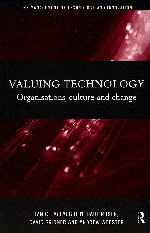

![]()
![]()

"Valuing Technology" is written explicitly from a sociological perspective. It mainly refers to two key concepts: the social studies of technology and the sociology of consumption. These two key concepts are introduced in the first part of the book. The authors then apply them to distinguish their research from conventional approaches which view information technology as a mere physical object independent of its social genesis. In doing so, they try to show that technological development in organisations is a social and political process influenced by particular social relations and different meanings, interpretations and interests. Moreover, McLaughlin et al. see modern societies as consumption cultures where "we live in order to consume", thereby defining the meaning, significance and value of goods (or technologies) that are consumed (p. 7).
To evaluate the importance of the social context, the authors analyse the acquisition of techno-organisational change on the basis of three quite different case studies within the retail, health care and higher education sectors. In the second part of the book, the reader can find detailed descriptions of how the acquisition and use of new technologies was related to such particular social settings in each firm such as; organisational structure, patterns of professional control, organisational culture and the gendering of technological systems.
However, the third and last part of the book is the highlight of this study. Both the comparative discussion of the three cases studies, in addition to well-selected core interviews indicate in detail the differences and similarities in how the actors in each case developed or avoided developing value in the newly acquired IT system. One of the main interests of the researchers was to compare the different experiences of how the consumption of technology in each organisation involved the production and maintenance of usability and utility values for technology. The distinction between these two values is central to the authors' argument in the first half of the comparative section of the book. Although they see a strong relationship between the users' finding that the system is usable and their finding that it also has a utility, the authors reach the conclusion that utility does not require the pre-existence of usability (p. 195). In this sense, they argue that differences in the development of both values and the strength of the link between usability and utility are shaped and influenced in each case by organising practices, and cultural and regulatory patterns. The second part of the comparative analysis discusses how the acquisition of new IT systems ends and becomes integral to daily routines. The empirical findings are used to reconsider common ideas of social studies of technology that the stabilisation of a new technology marks a temporary end to sociotechnical change. Alternatively, the researchers demonstrate that the closure of the acquisition process did not bring an end to the diversity of meanings. On the basis of their case, McLaughlin et al. illustrate that along with dominant meanings, alternative ways of interpretation and local interests still play a role and could have destabilising effects down the line.
The empirical findings of this book present a rich and detailed picture describing how the acquisition and application of new technologies cannot purely be understood as a technical or an instrumental process. Consequently, the argument throughout the book is to understand technologies in relational terms. Thus, "for the first, technology is constructed as a result of the relations between negotiated (and negotiating) positions of different social actors; for the second, the value of any consumer good lies not in any intrinsic property it has but in its relation to other goods" (p. 226).
All in all, the book convincingly demonstrates that social context matters in order to understand how new information becomes part of organisational life. However, the fact that the context was exclusively british raises questions concerning the context-specificity of their conclusions. Do the authors' empirical results apply only to the UK? Moreover, one could wonder whether the authors' view that the society in which we live is a consumption society is a sufficient enough explanation. From an organisational sociology viewpoint, such a position is unsatisfying because it neglects the influence of institutions on techno-organisational development.
Mike Geppert
Humboldt-University Berlin
